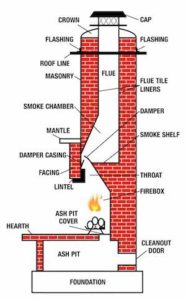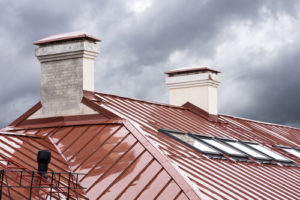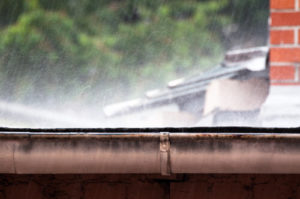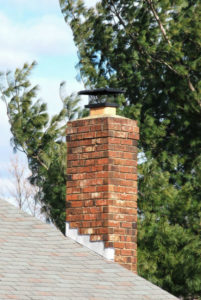by Billy Sweet | Mar 31, 2020 | Chimney Anatomy
Your chimney may be the biggest system in your home besides the central air and heating unit and there’s a lot that can go wrong with it. Because it’s so big and can cause big problems for your home, it’s important to understand just what makes up the chimney system, how it works, and how it can go wrong.
 Parts of the Chimney
Parts of the Chimney
From bottom to top, there are many parts and materials that make up a fireplace and chimney system. The terms ‘fireplace’ and ‘chimney’ are often used interchangeably, and they work together to get the job done. What we know as the fireplace is actually called the firebox, and what we know as the chimney is actually the flue. These are only two parts of a very large system that must be built and maintained properly. Only then will the system work efficiently and safely.
Foundation – Just as the house itself sits on a foundation that holds it up and prevents settlement and shifting as seasons and weather change the soil, the chimney requires a foundation. Oftentimes this foundation is built when the home is built, but not always.
Ash Dump – Some, but not all, chimneys have an ash dump. This is a space beneath the firebox where ashes can be pushed and stored to cool and collect over time. A chimney sweep can remove these ashes as needed through a cleanout door near the foundation—a service that usually isn’t required for several years.
Hearth – The hearth is the floor of the firebox which usually extends from the back of the fireplace out into the room a bit and is made of a particular firebrick and refractory mortar that protects against heat transfer from the fire.
Firebox – The space where the fire sits and burns is called the firebox. It endures the highest temperatures for the longest periods but receives the least attention. The firebox is constructed of firebricks and refractory mortar.
Damper – The damper is a mechanism, usually made of metal, installed at the top of the firebox and opens and closes the flue opening. When the damper is closed, very little air moves through the chimney system. When the flue is open, air flows freely.
Smoke Chamber – The space above the firebox is called the smoke chamber—so named because this is where the particles and gases mingle with the heat to rise up the chimney. It is shaped like an inverted funnel to direct smoke upward and into the flue. Beneath the smoke chamber, there is a shelf (called the smoke shelf) designed to prevent smoke from falling back into the firebox and into the home. The walls of the smoke chamber should be at certain angles and smooth.
Flue – The flue is the interior vent by which smoke and gases travel out of the home. The surface of the flue should be covered with a liner that keeps heat and corrosive chemicals from damaging or moving through the masonry and gives it a seamless, smooth surface for optimum airflow.
Masonry Crown – At the top of the chimney there is a ceiling that extends from the flue opening to the edge of the chimney. The crown is made out of durable material that can withstand harsh temperatures, sunlight, and precipitation. It is also made at a slant so that water runs away from the flow and onto a drip edge, where it drips down onto the flashing at the roof instead of running down the masonry.
Chimney Cap – The chimney cap is the roof of the chimney system. It keeps water, animals, wind, and weather out. The cap is necessary to prevent chimney water damage and animal intrusion. It is often made of copper or stainless steel.
Common Chimney Problems
Even a well-constructed chimney can become damaged over time—especially through particularly rough winters or when subjected to coastal air and moisture.
- Spalling masonry can be particularly devastating to chimneys that stand in coastal regions. This is when the mortar cracks and falls away, causing bricks to loosen and take on water.
- Leaky chimneys can lead to damaged parts of the chimney, but also water damage throughout the house. A chimney leak can occur in any season and cause damage year-round.
- Smoky fireplaces are usually caused by an obstruction, draft issue, or even the wrong firewood being burned in the fireplace! A smoky fireplace doesn’t always require a repair but should always be troubleshot and a professional should be called if the problem persists.
- Liner damage is most often due to an old clay tile liner becoming worn out and breaking apart. You might find pieces of clay tile in your firebox or notice problems like masonry that is hot to the touch. Liner damage can also be caused by a dirty flue or a flue fire.
Whether your system is old or new, whether you have a fireplace, a stove, or an insert, whether you burn wood, pellets, or gas, your chimney is important. It can be a great asset, but can also be very dangerous. Make sure you know the ins and outs of chimney function and maintenance. Make sure your chimney system is safe and efficient. It will work better and for longer.
Call and schedule services with Billy Sweet Chimney Sweep today by calling 617-469-4528
by Billy Sweet | Aug 28, 2019 | Waterproofing
Of all the things that can shorten the life of a perfectly good chimney, water is the worst. Not only does water wreak havoc on masonry—the very substance your chimney is made of—but it is everywhere. Water comes in different forms all year round. When temperatures fall, water in the chimney is even worse. Fortunately for our customers with masonry chimneys, there is something we can do to prevent water damage during all seasons, and year after year.
Water and Your Chimney
Because of the materials that make up masonry, water is best avoided. The porous nature of masonry is perfect for venting your fires, allowing smoke, gas, and heat to release through the brick and mortar. This also allows water in through the masonry—unless it’s prevented. At Billy Sweet Chimney Sweep, we recommend preventing chimney leaks before damage occurs.
Your chimney leak can lead to:
- Rusted parts and assemblies
- Tilted/collapsed/settled chimney
- Cracked/damaged flue liner
- Deteriorated central heat
- Clogged clean-out system
- Rotting adjacent wood/wall coverings
- Water stained bricks/walls
In addition to physical damage, your leaky chimney may also result in a drop in efficiency. A drop in efficiency means a rise in fire risk, putting your home and your family at risk.
Prevent Leaks From the Top Down
In order for your chimney to be truly waterproof, it must have all the necessary parts installed and in proper working order. The first thing we check when we get a call about a leaky chimney is the flashing. It is often improperly installed and a common point of water entry. The chimney must also have a chimney cap and crown to shed water from the top of the chimney.
Once all these components are in place, we can take it one step further by waterproofing the masonry itself. Our waterproofing agent is vapor-permeable which means the heat and gas produced by your fire will still be able to escape but water molecules will not be allowed in. This barrier penetrates deeply into the masonry so even cracks and gaps are protected from water penetration—and this protection lasts ten years!
When to Schedule Waterproofing
If you have never had your chimney masonry waterproofed or it has been more than a decade, it’s time to schedule this important appointment. Other water repellants and sealants from your local hardware store are not enough. In fact, most of them do more harm than good. Most sealants and repellants may keep water out, but also seal gases and moisture IN. This leads to a host of other problems. Let our team at Billy Sweet Chimney Sweep do the job, and get it right the first time.
We also install chimney caps, repair and install flashing, replace throat dampers with new, top-sealing dampers with an airtight seal, and repair and seal damaged crowns.
Don’t wait. Have your chimney waterproofed now, and you won’t have to worry about the water freezing in your masonry this winter. Worry about the rest of your summer, and leave the chimney up to us!
Call our Boston, North Shore, or Portland location today.
by Billy Sweet | Mar 13, 2019 | Leaky Chimney
Your chimney is designed to withstand time and weather, but it will only hold up as long as it’s properly maintained and used correctly. Part of this chimney care is professional and routinely scheduled services through a licensed and certified chimney sweep company. During these chimney checkups, your system will be assessed for overall safety and structure. Neglecting these appointments can mean a disaster for your chimney, especially when it leads to a leak.
Leaky Chimneys
Causes:
-Missing chimney caps are a major cause for leaky chimneys because the cap serves as a roof for the flue. Without it, precipitation freely falls into the flue and can damage the system from the inside out.
-Damaged or dislodged flashing allows water into the intersection of the roof and chimney. The flashing should be installed professionally so that it protects against water, and should not be nailed or covered in sealant.
-A cracked or damaged crown can allow water into the system from the top, whether water, snow, or ice. Once the crown is damaged, winter weather can add to the issue and worsen the problem.
-Masonry damage allows water into the chimney through masonry that is damaged or unprotected. Once allowed into the masonry, winter weather can damage the masonry throughout winter through the freeze/thaw cycle. Once the water penetrates the masonry, it can cause leaking in the flue and even more damage to the masonry.
Signs:
-Sounds of dripping in the fireplace or chimney system
-White stains on the outside of the masonry, red rust stains at the top of the chimney exterior, and green or black stains in the firebox
-Visible water dripping in the firebox or running along the chimney
-Leaks around the chimney or in other rooms of the house
-Smells of mildew or mold
Water Damage
Chimney leaks are 100 percent preventable, and spending the time and money necessary to prevent the leak will prevent damage later. Your chimney leak can cause leaking in the system and throughout the rest of the home, ruining wall coverings, furniture, and wreaking havoc on the chimney system itself.
When there is a chimney leak, it can cause damage to the working parts of the system, rust to the damper, door hinges, and components, stains and deterioration, and clogged cleanout doors and flues.
Professional Leak-Proofing
Our customers in and around Boston depend on us for chimney waterproofing year-round. We replace chimney caps, repair and replace chimney crown, install flashing, and even waterproof masonry for good measure. Our waterproofing services will protect your masonry completely from water penetration while allowing the heat and gases out. This vapor-permeable water repellent allows the masonry to breathe and vent properly, unlike many purported water-repellents on the market.
In order to prevent leaks this spring, make sure your masonry doesn’t have any winter damage that can allow spring showers to penetrate your chimney system. Call Billy Sweet Chimney Sweep today and let an expert check out your system for possible leaks and apply a waterproofing agent that will last years.
Dial 617-469-4528 to reach our Boston office today.
by Billy Sweet | Aug 13, 2018 | Waterproofing
Your chimney may look healthy from the outside, but it may have a hidden problem that is wreaking havoc on all of the unseen parts. Because of the porous nature of masonry and the materials it is made of, masonry chimneys are highly susceptible to water penetration and damage, which may go unseen for many weeks or even months before anyone notices signs of a problem. By this time there is usually serious unseen damage within the system–damage that is 100 percent preventable.
Water Damage
Whether it falls in through an exposed flue, penetrates through the masonry, or seeps in through damaged flashing, water will produce the same result–damage. Water doesn’t only damage parts of the chimney itself, but usually results in other leaks that affect your home. When water comes in through the chimney system, it will travel through the structure of your home, in ceilings, floors, and walls until it pools in one low area where it will form a leak. For this reason, if you have a leak anywhere in your home, even rooms away from your chimney, it’s important to call a chimney professional. The chimney is the first thing that should be checked because it’s usually the culprit. Besides damage to the home, walls, floors, and furniture, the chimney takes on damage that is costly to repair.
Water causes serious damage to the chimney, including:
-Rust to parts, assemblies, ducts, and connections
-Deterioration of assemblies, masonry, mortar, and mortar joints
-Rotting adjacent wood, wall coverings, walls, and floors
-Water stains in home and masonry (interior and exterior portions)
-Cracks and damage to flue lining system
-Collapsed hearth support and foundation damage
-Leaning, tilted, or collapsed chimney structure
-Chimney settlement
-Odors, spores, and mold affecting breathable air in the home
Preventing Water Damage
At Billy Sweet Chimney Sweep we understand the importance of water damage prevention due to our sometimes harsh winters and proximity to ocean waters. Falling precipitation isn’t the only water that can penetrate the chimney system. Moisture in the air, especially corrosive moisture such as salt water, can be just as damaging to the masonry. It’s important to schedule routine maintenance with a chimney professional in order to make sure your chimney is protected against water penetration. At Billy Sweet we offer chimney inspections year round that will identify problems and hazards that put your chimney and home at risk. We also diagnose leaky chimneys, and the first thing we’ll check is the flashing because it’s often installed incorrectly. Billy Sweet will also check that your flashing, cap, crown, and masonry is in good shape and will keep water out. To add extra protection to the masonry, we apply a waterproofing product that will keep water out year after year.
Functional Waterproofing
It’s unsafe to put latex sealant or other outdoor water repellent products on your masonry. They may keep water out, but the chimney won’t work properly, or safely. The water repellent that we use at Billy Sweet actually repels water, keeping water molecules from getting in, while still remaining vapor-permeable so that gas and heat can escape.
We not only waterproof chimneys year-round, but we offer this service free after exterior masonry repairs!
To schedule your waterproofing services, call 781-593-2333 or contact us online.
by Billy Sweet | Jun 8, 2016 | Chimney Maintenance
Chimney caps are the most inexpensive way to prevent water penetration to the the chimney system.  The chimney cap covers the flue opening to keep the weather out, and here in New England we get a fair share of weather. Although the chimney cap is sometimes called a rain cover, it is essential for winter weather as well.
The chimney cap covers the flue opening to keep the weather out, and here in New England we get a fair share of weather. Although the chimney cap is sometimes called a rain cover, it is essential for winter weather as well.
Keep the Outside Out and the Inside In
—Weather
The average snowfall for one year is enough to wreak havoc on a chimney, especially in New England. The process of freezing, thawing, and expanding through one cycle of seasons causes extensive damage to the chimney system. The chimney cap prevents rain water and snow from entering the flue opening.
—Wildlife
Throughout the seasons various animals like to climb into chimneys and nest in the safety and warmth there. Throughout the year a chimney can become a habitat for small animals like squirrels, raccoons, and birds. Some animals, depending on the location, are protected, like the Chimney Swift. If a Chimney Swift nests in your chimney, it cannot be removed, and the chimney cannot be cleaned or used until the young birds have left the nest.
—Sparks
When a fire is burning particularly hot, it’s common for sparks and other byproducts to fly up through the flue. Without a chimney cap these sparks can ignite debris on the roof, or in a yard below or nearby.
When to Call a Professional
The Chimney Safety Institute of America (CSIA) recommends regular chimney sweeps and annual inspections for safe and efficient use of fireplace and chimney systems. It’s at these appointments that a professional would notice a missing, incorrectly installed, or damaged chimney cap.
Other good times to make an appointment with a CSIA Certified Chimney Sweep® (CCS) are after the sale or transfer of a house, when fuel type is changed, or when changes are made to the system (including natural disasters and fire damage).
A Billy Sweet Chimney Sweep knows what is expected of chimneys in the Boston area. We pride ourselves on expert training and experience that puts our sweeps at the top of the industry for chimney maintenance. We offer waterproofing services and repairs to leaky chimneys, at fair rates and professional service.
Water Damage
Billy Sweet Chimney Sweeps make it our top priority to keep your fireplace system working and safe for your family, home, or business. When water is allowed to penetrate the chimney system it can affect everything, as the chimney is a system of many parts. Water damage can cause, rust, rot, deterioration, cracks, decay, stains, and more.
Call a Billy Sweet Chimney Sweep today or make an appointment online to check your chimney cap.
 Parts of the Chimney
Parts of the Chimney



 The chimney cap covers the flue opening to keep the weather out, and here in New England we get a fair share of weather. Although the chimney cap is sometimes called a rain cover, it is essential for winter weather as well.
The chimney cap covers the flue opening to keep the weather out, and here in New England we get a fair share of weather. Although the chimney cap is sometimes called a rain cover, it is essential for winter weather as well.